Experience the Yangtze River Delta region on the G8388
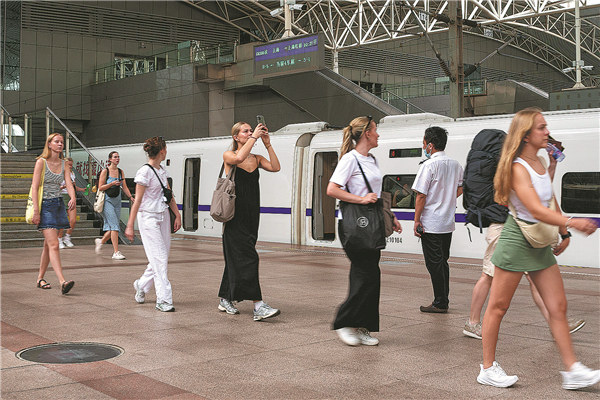
Every evening, the G8388 high-speed train pulls into Shanghai Hongqiao Station, its terminal stop — 15 kilometers from its starting point of Shanghai Railway Station — after a loop spanning over 1,200 kilometers.
This loop line, an 8-hour and 9-minute journey, crisscrosses the densely populated and economically vital Yangtze River Delta region. Major hubs, red-hot traffic arteries and dense passenger links are featured along this new high-speed rail loop.
Since its launch on June 15, the G8388 loop has witnessed soaring demand, with about 349,000 riders as of Sept 9 and an average occupancy rate of 90 percent. Even after the summer travel period, the train remains almost fully booked, with another peak expected during the upcoming National Day holiday at the beginning of October.
More than just a transportation line, the G8388 journey immerses travelers in the rich tourism resources of the region. It connects the major cities of Shanghai, Nanjing in Jiangsu province, Hefei in Anhui province, and Hangzhou in Zhejiang province, as well as more remote towns to urban centers, and it better connects the region's numerous tourist attractions.
Along the way, the rail route provides access to rich historical sites, scenic mountains and waters, and ancient cultures including classical gardens, the "homeland of honey peaches" of Yangshan, Huangshan Mountain, Qiandao Lake, West Lake and Shanghai's only preserved fishing village — destinations celebrated across China and internationally.
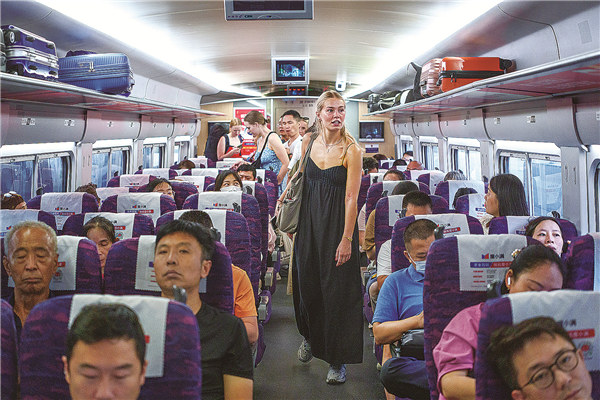
As China's inbound tourism market continues to recover, international flights are increasing and the government implemented the 144-hour visa-free transit policy, the new loop line has seen many foreign passengers. Additionally, rail authorities have released supportive measures to facilitate smooth traveling.
Shanghai Railway has added bilingual volunteers and information at ticket windows and entrances, with a dedicated window for passport verification. Mobile payment via WeChat and Alipay has also been enabled at windows and station shops, allowing international visitors to easily make purchases using foreign bank cards. Official statistics show that Shanghai Railway has provided ticket and passport verification services to nearly 10,000 railway passengers since the beginning of 2024.
Embark on the G8388 to experience the various attractions of the Yangtze River Delta region, where natural and human landscapes are connected by this convenient transportation loop.
The loop train G8388:
Route length: 1,288 kilometers
Duration time: 8 hours and 9 minutes
Stations: 21 along the loop
Departure and arrival: The train departs from Shanghai Railway Station at 10:27 am and arrives at Shanghai Hongqiao Railway Station at 6:36 pm.
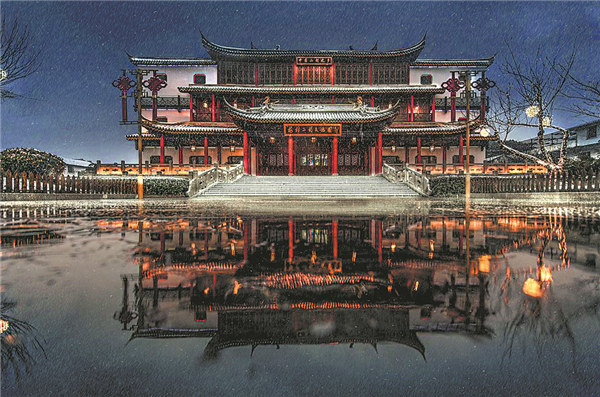
Wuxi — Musical instrument evolves with modern vigor
Wuxi, Jiangsu province, represents a vital cultural hub of Jiangnan (lower reaches of the Yangtze River) civilization and a popular tourist destination with acclaimed attractions and historical sites.
When it comes to Wuxi-made musical instruments, the erhu (two-stringed fiddle) is the most widely recognized. Arriving at the Wuxi New District Railway Station provides easy access to Meicun village, which is known to be "China's capital of the erhu" for over 50 years.
From its clusters of over 10 renowned workshops and brands, the village crafts nearly 50,000 erhu annually, accounting for approximately one-quarter of the domestic market share for midrange to premium models.
Yet Meicun's cultural resonance extends beyond its erhu makers' efforts into new generational realms.
A social media sensation has injected new enthusiasm for this traditional two-stringed fiddle among young audiences worldwide. Better known by his online persona Er Bing Hu La, Ma Yunfei mesmerizes over 3.7 million followers with his unique erhu showmanship, performing not just a traditional repertoire but also pop covers.
Ma's popularity sparked the interest of the venerable erhu brand Wanqixing, a name operating under legendary erhu-making master Wan Qixing. The implications extend far beyond simple marketing, however. Through his livestreams watched by tens of thousands of viewers, Ma has inspired legions of students from all walks of life and countries.
The young musician is aiming for a higher calling. "Before 30, I wanted to learn as much as possible and see the world," Ma reflects. "Now that I have, my next 20 years will be spent mastering the making of this instrument — that becomes my life's purpose."
Meicun became Ma's new home, where dozens of erhu workshops upholding storied brands are housed.
"An erhu consists of four main components — the sound box, neck, strings and bracketing," explains Bu Guangjun, a master erhu maker who was Wan's apprentice. "Each is fitted with painstaking precision."
"You can't simply measure snakeskin thickness with a ruler," notes Bu of the nuances that separate machine-made from handcrafted erhu. "It takes experience to judge the distinctive texture and breathe life into an instrument with soul."
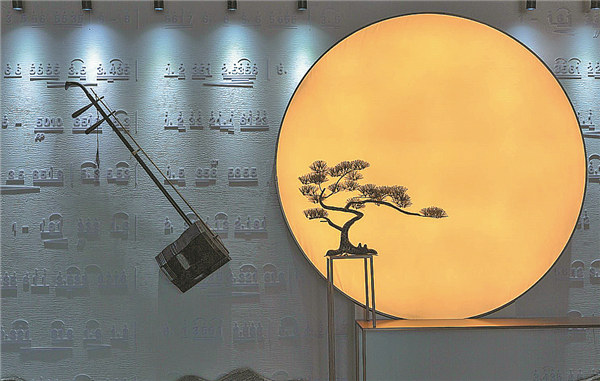
From the 1960s onward, Meicun fostered folk instrument workshops to elevate its erhu craftsmanship.
"People from home and abroad come here to see how these iconic instruments are made traditionally," says Bu. "It sparks pride once they realize the skill involved, instead of just viewing it as antiquated."
The new generation of erhu makers aims to enrich the village's inheritance. "Previously, the erhu was slimmer for speed and traditional sensibilities," Bu says of the evolving aesthetic. "The previous generation enlarged it slightly for more volume without losing its quintessential qualities."
"Now, we pursue an adaptive philosophy — retaining core traditions while accommodating a modern, sometimes even northern repertoire, never conceived of ages ago. We've elongated the neck, modified the curves and thickness — all to unite historically distinct regional styles into one universally expressive voice," Bu explains.
"To truly revive appreciation for our heritage instruments," says Bu, "people must feel that playing the erhu is just as cool as the violin — an inherent point of cultural pride."
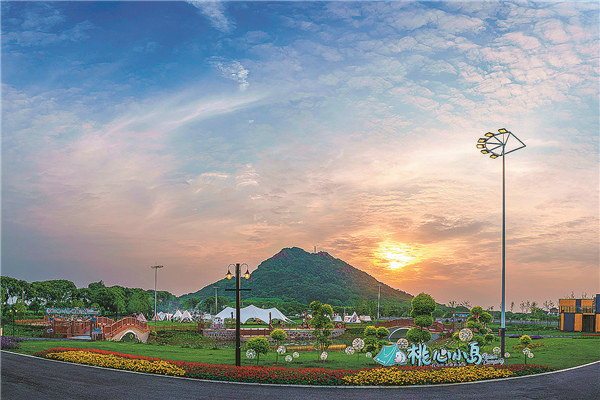
Huishan — Blossoming into peachy tourist venue
Traveling by train from the Wuxi New District Railway Station to Huishan Railway Station takes only 15 minutes. If you're not familiar with Huishan, you've probably heard of Yangshan honey peaches, which The Wall Street Journal once dubbed "the most delicious peaches in the world".
In recent years, Huishan, also part of the city of Wuxi in Jiangsu province, has undergone a significant transformation, evolving from its roots as the "Homeland of Honey Peaches" to a multidimensional tourist destination centered on its iconic fruit.
The transformation did not occur overnight. In recent decades, Huishan's Yangshan town has integrated its peach cultivation and sales operations with high-efficiency agriculture, sightseeing farms and visitor experiences.
Using its billion-year-old volcanic resources and vast peach orchards, the town created a pastoral integrated resort concept combining rural tourism, country living, wellness retreats and family vacations.
One example is the Yangshan Peach Blossom Festival, which began in 1997 and has grown into an annual celebration attracting thousands of visitors who come to admire the blooms and peaches and indulge in an ever-expanding array of peach-infused products. Now, the town welcomes over 2 million visitors each year.
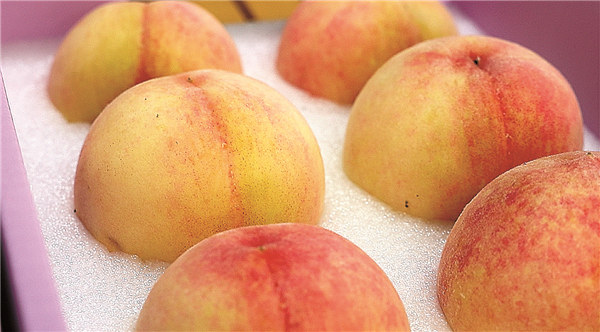
Today, over 50 distinct businesses spanning eco-agriculture, cultural creativity, leisure, gastronomy, science education, wellness and outdoor adventures have established themselves here, collectively transforming the local economy from a single "peach" into an industry chain worth more than 1.6 billion yuan ($225.47 million).
Yangshan's scenic highlights include the peach island scenic park, which consists of peach-themed islands, gardens and more. Dongfang peach-oriented village provides field parks, rural living academies, agricultural exhibits and intangible heritage experiences.
Moreover, the 80-acre peach heart island camping base features bustling night markets, music stages and a variety of camping options.
Jiangsu province boasts more than homes of fruits and musical instruments. The classical gardens of Suzhou, which is also part of the loop line, are among China's most famous and exquisite blend of pavilions, ponds, rockeries and plants into one landscape. Wuxi's Taihu Lake region features the scenic area of Turtle Head Isle, with its lush mountains, ancient temples and traditional garden estates overlooking the lake's waters.
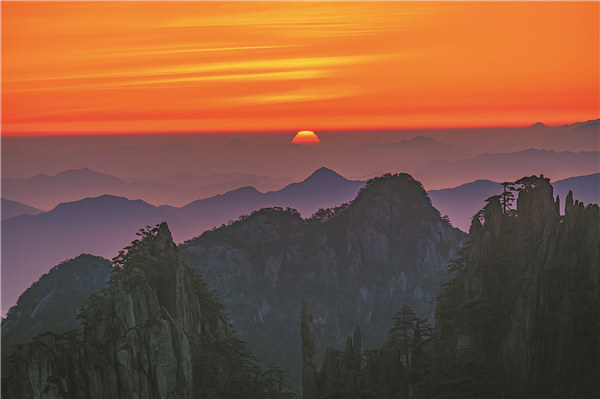
Huangshan Mountain — Ancient attraction gets slice of American pizza pie
There is an old saying that, "after visiting Huangshan, you don't need to visit any other mountains in China". Huangshan Mountain in East China's Anhui province is a national treasure and a wonder of the world, as well as a symbol of the province.
This year, Huangshan garnered even more attention with the reopening of Tiandu Peak in May after a five-year closure to protect its local ecology and natural resources.
Tiandu Peak is one of Huangshan's three major peaks. Towering 1,829 meters above sea level, it draws huge crowds to its precipitous terrain and breathtaking scenery. In particular, the route dubbed "fish back ridge" features a near-vertical 85-degree slope over 10 meters long but less than 1 meter wide, protected only by railings and rope.
Located miles from the Huangshan Mountain and near Huangshan North Railway Station, the thousand-year-old village of Nanxinan in Huangshan city seems an unlikely setting for one of China's pizza innovators. However, in this ancient Anhui hamlet steeped in ancient tradition, a foreigner has fused East and West in an aromatic, unlikely creation — the Chou Guiyu (stinky mandarin fish) pizza.
In this area, where traditions like preserving food have endured for centuries, American Adrien Brill is forging paths toward new ones while preserving its flavors.
Brill, who has called China home for 15 years, did not intend to reinvent any dishes when he moved to his wife's hometown of Huangshan seven years ago.
However, Brill was invited to participate in a cooking competition as an amateur home chef, which features the local famous preserved fish dish.
"I was shocked and nervous since I'm not a professional chef," Brill recalls with a chuckle. "But I was already falling in love with making pizza, so we thought why not try putting Chou Guiyu on it? It represents the Western culture of pizza but also the local flavors I've grown to love here."

While the idea seemed weird, the taste proved to be a unique, delicious cultural intersection and has become the signature dish at Brill's restaurant named after his Chinese moniker Zhuowen.
"At first, people think it's weird, but once they try it, they're always surprised by how good it tastes," Brill says. "It's not overpowering or too salty or stinky. The flavors work together seamlessly."
With the help of his wife who was born and raised in Huangshan, he has experimented with other local ingredients like the funky aged "hairy tofu" or mao doufu. Seasonal specials have featured pumpkin, mushrooms and sausage inspired by the fall harvest festival of shai qiu, when villagers preserve crops for winter.
While sitting in the rustic countryside of Nanxinan, Brill remains energized by the warmth and support from locals like his neighbor Lao Wu (one surnamed Wu). On his first day renovating the restaurant space years ago, Wu insisted Brill join his family for a home-cooked lunch.
"The environment here is incredibly healthy, peaceful and welcoming," reflects Brill. "Wu and other locals constantly make you feel loved with smiles, warmth and help like I'm part of one big family."
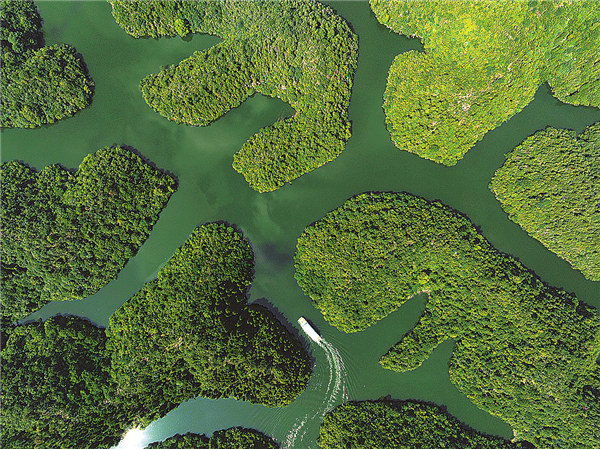
Qiandao Lake — Asian Games location finds new life
The Qiandaohu Station in Zhejiang province is named after Qiandao Lake, or "Thousand Island Lake", which has long been a popular tourist destination for those seeking a tranquil and peaceful vacation. However, after hosting a sports event, it was injected with a "sporting gene".
It can be challenging to repurpose venues after major sporting events, yet at the heart of Qiandao Lake, the Hangzhou Asian Games have led to a sustainable solution.
The former Asian Games Cycling Village, a 48-kilometer drive from Qiandaohu Station, has been transformed into an ecotourism complex called Qiandao Lake Beautiful China Resort.
"The existing athletic facilities provided an excellent foundation with venues, cycling routes, hiking trails and more," says Wang Dan, marketing manager of the resort.
The project aims to create China's premier lakeside destination integrating sports, nature, entertainment and wellness, leveraging the Asian Games legacy infrastructure. "Our resort offers over 60 recreation facilities spanning 200 different activities," Wang adds.
Wang highlights the resort's strong sports and outdoor DNA. "Our most popular activities leverage the area's natural scenery — cycling along the lake's ring roads, hiking the scenic island trails and exploring abundant islands."
For tourists, the traditional experience here is still visiting the lake, which features over 1,000 islands of various sizes and shapes, says Wang. "Despite adding more novel events, this year we've developed a maze trail, providing a unique island maze view quite different from the lake's typical vantage points."
For now, the resort is mainly drawing regional visitors, with around 70 percent coming from Yangtze River Delta cities like Shanghai. "Some self-driving tourists liked it so much they said they'd take the high-speed rail next time for easier access," Wang adds.
Looking ahead, Wang shares their expansion plans: "We hope to develop a large-scale integrated destination resort. And the current settings only cover about a quarter of the over 667-hectare total planned area."
"We're also exploring local options like orange picking experiences, as well as caviar tastings," Wang adds.
In recent years, China has become the world's largest caviar exporter, with Qiandao Lake being one major pond for raising fish with Hangzhou Qiandaohu Xunlong Sci-tech Development Co as the main provider.
"We established our first Qiandao Lake aquaculture facility in 2003. The key reasons for selecting this location were the extraordinary water quality and the area's abundant forest coverage," says Zhang Shaofeng from the company's marketing department.

With a high rate of forest land, dissolved oxygen levels in the lake's waters are optimal and there is no need to utilize additional oxygenation equipment commonly required on fish farms, Zhang adds. "The lake environment closely mirrors the native habitat, ensuring our fish remain vigorous."
The caviar, harvested from river sturgeon, has been selected by numerous Michelinstar restaurants and served at international events such as the G20 Summit banquet in Hangzhou, Zhejiang province.
"Our 'Kaluga Queen' brand caviar has approximately 35 to 40 percent of the global market share," Zhang says.
From the first jar produced in 2006, Kaluga Queen caviar has gradually penetrated international markets. While the company's aquaculture output ranks first globally, Zhang says they have plans to expand into the tourism market.
"As Qiandao Lake is a popular tourism destination, we are exploring opportunities to expand our cultural and recreational offerings. We are considering organizing experiential activities for visitors at our aquaculture facilities," says Zhang.
Also part of the Zhejiang section of the loop line is the West Lake area, a highlight of China's landscape and cultural attractions for over a millennium. Beyond the lake's iconic arched bridges and pagodas lies the vast Xixi National Wetland Park teeming with diverse flora and fauna.
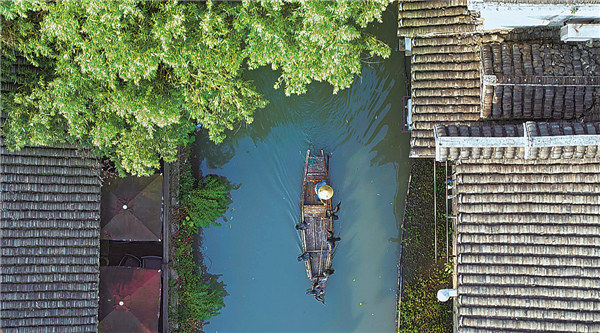
Jinshanzui — The city's last fishing village
The Jinshan North Station offers visitors a unique opportunity to experience nature and history in this coastal district.
For over a millennium, the village of Jinshanzui in Jinshan district in Shanghai has lived on the waters of Hangzhou Bay. The seaside community offers vistas of the three Jinshan Islands across glistening waters.
In the 1980s, Jinshanzui was a fishing hub with over 1,000 fishermen. While most villagers have long since traded their nets for other pursuits, former fishermen can still be found in the old town's alleyways.
"The residents have been drawing on the sea for generations," explains Wu Xuehong, deputy general manager of Jinshanzui Fishing Village Investment Management. "Now, rather than fishing to protect ocean resources, we aim to preserve that heritage."
Over the past decade, a transformation has breathed new life into the old fishing village, says Wu, adding that renovations since 2010 have rejuvenated Jinshanzui's historic town quarter, adding eight thematic exhibition halls showcasing traditional fishing gear, boat models, aquatic life displays and more.
Immersive hands-on activities like net weaving and knot tying are designed to allow visitors to experience authentic maritime crafts firsthand, Wu adds.
A lively seafood street and village market offer a taste of local delicacies like dried fish, shrimp, abalone and jellyfish. From various stalls, residents sell simple sun-dried seafood snacks using centuries-old techniques.
This revitalization has given new economic opportunities benefiting Jinshanzui's people. According to Wu, over 200 villagers now derive their livelihoods from seafood restaurants, guest homes, cultural experiences and other tourism-related enterprises. Homes that previously sat vacant have been re-purposed into lodges for residence or commercial activities, providing owners with rental incomes ranging from 50,000 to 300,000 yuan ($7,100-42,600) yearly.
"Through tourism, we're able to welcome around 1 million visitors annually," notes Wu.
While new things go viral, old memories are also preserved. In the village lived a former fisherman Yang Huogen, who records memories of life at sea through vivid paintings.
"I retired in 1997 and saw that the fishing grounds were no longer being worked," Yang says. "I realized that no one would be going out to sea to fish anymore and there were not many photographs documenting how hard we fishermen used to toil. So I decided to paint scenes showing the backbreaking labor of our former lives, to ensure future generations understand what we went through."
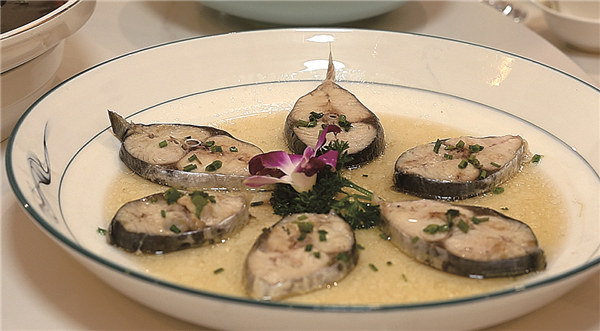
One of the centerpieces is Yang's 30-meter scrolling panorama depicting the working lives of fishermen across all four seasons. Additional albums document the village's evolution from his childhood.
"I wanted to capture our arduous past for future generations," explains the elderly artist. "With few going to sea nowadays, my paintings ensure our traditions endure."
There are also books delving into the area's intangible cultural heritage. Ethnographic records document Jinshanzui's storied history, customs, cuisine, lodging practices, and more, while folklore anthologies capture poetic marine verses and stories passed down through the ages.
"We're dedicated to safeguarding the village's unique identity," Wu says.
Aside from being the only preserved fishing village, Jinshan is also known for having the largest beach in Shanghai, as well as offering other unique experiences with diverse entertainment activities such as the first aqua kart in the East China region.
Notably, one of the world's largest LEGO theme parks is set to open near the Jinshan North Station in the summer of 2025, cementing Jinshan as a must-see tourist destination in the region.